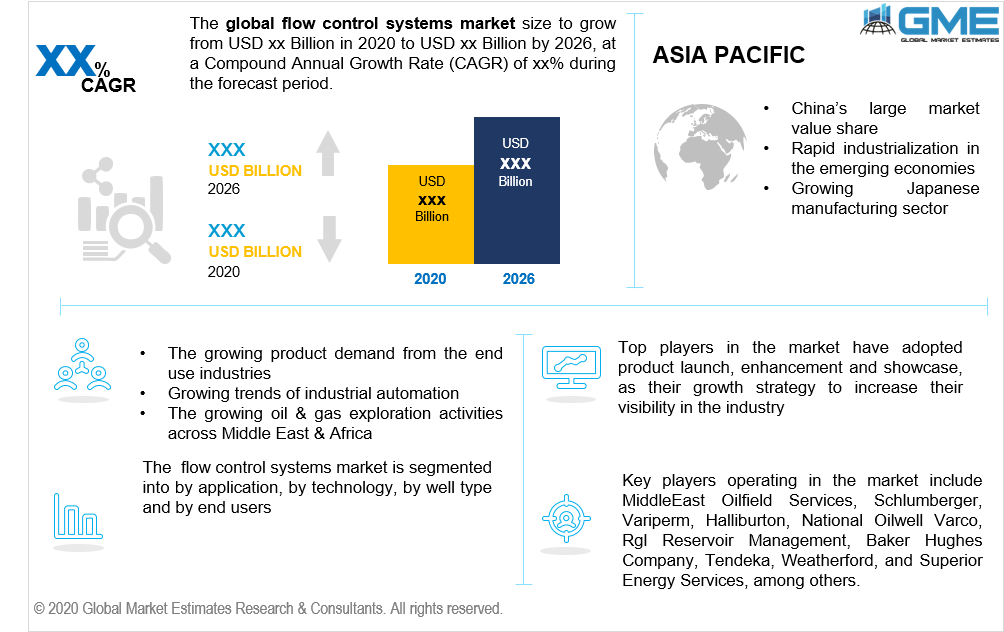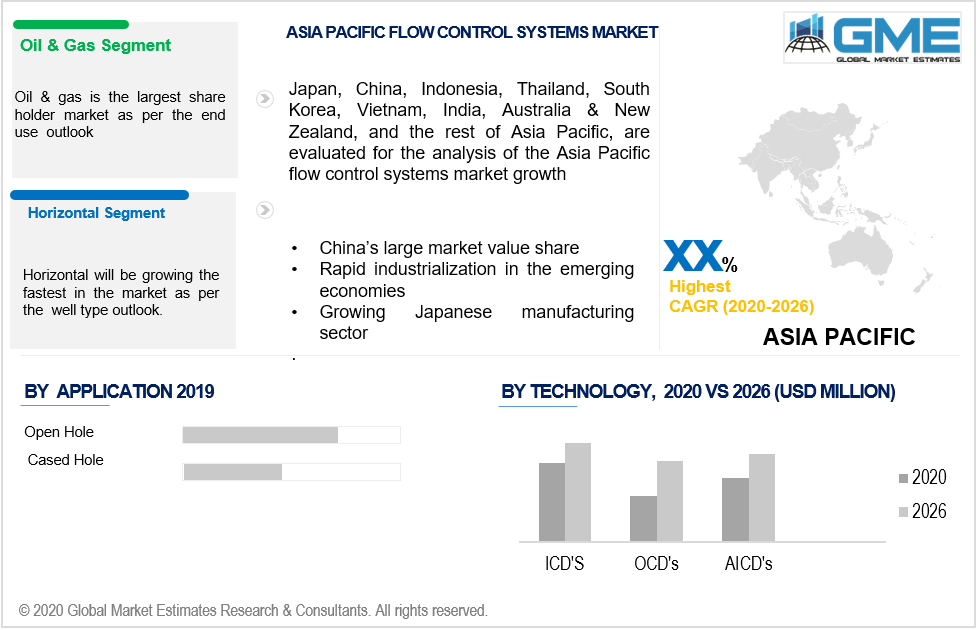
Global Flow Control Systems Market Size, Trends, and Analysis – Forecasts to 2026 By Technology (ICDs - Inflow control devices, OCDs - Outflow control devices, AICDs - Autonomous inflow control devices), By Well Type (Horizontal, Vertica), By Application (Open hole, Cased hole), By End User (Oil & Gas, Power, Construction, Marine, Mining, Others), By Region (North America, Asia-Pacific, Middle East & Africa, CSA, Europe), End-User Landscape and Company Market Share Analysis and Competitor Analysis
Flow control systems market will register an upward trend between the forecast period. Flow control solutions regulate the flow or pressure of liquid and gases. The growing product demand from the end-use industries such as oil & gas, power, and construction among others are driving the market growth. Flow control solutions are ideal for inflow optimization and production maximization, and suitable for vertical, deviated, and horizontal completions. The growing trends of industrial automation among different industries is also boosting the market growth for flow control solutions. An increasing number of power generation plants along with increasing consumption of power in developing economies is also supporting the market growth. The growing oil & gas exploration activities across the Middle East & Africa and North America are propelling market growth. Flow control solutions offer pressure and temperature control during down streams, upstreams, and mid streams.

Based on the application, the market considers open hole and cased hole. The cased hole segment will register exceptional growth in the market. Cased-hole flow control methods are widely preferred due to their technical reasons relating to the stability of the hole. Cased-hole logging is used to help operators obtain additional information from a well or reservoir that has already been completed.
Based on well type, the market is considered into horizontal and vertical. The horizontal well type segment will hold the largest market share between 2020-2026. Horizontal drilling and multistage hydraulic fracturing help increase the surface area of the reservoir that is in contact with the wellbore, which unlocks a huge quantity of natural gas in reservoirs. Operators are developing solutions to overcome the challenges while production, such as water shutoffs, and wax formations, which are higher in horizontal wells as compared to vertical wells.
By end-users, the market is divided into oil & gas, power, construction, marine, and mining, among others. The oil & gas segment will hold the maximum share between 2020-2026. The oil & gas industry is involved in the treatment, production, distribution, and processing of hydrocarbon fluids, and gases. The growing demand for petrol and diesel among the developed economies is positively impacting the market. The rising population and growing usage of passenger vehicles and cooking gas are also supporting the market growth. The flow controllers are widely used in the oil & gas applications such as upstream production, pipeline detection, and gas processing among others.

Based on the region, Asia Pacific will emerge as a prominent leader in the market for flow control systems. China will register a large share and will dominate the market between 2020-2026. Rapid industrialization in emerging economies such as China, India, Japan, and South Korea among others is also boosting the market growth. The growing manufacturing sector along with the growing usage of oil & gas in the region is also propelling the market growth.
Key players operating in the market include MiddleEast Oilfield Services, Schlumberger, Variperm, Halliburton, National Oilwell Varco, Rgl Reservoir Management, Baker Hughes Company, Tendeka, Weatherford, and Superior Energy Services, among others.
Please note: This is not an exhaustive list of companies profiled in the report.
We value your investment and offer free customization with every report to fulfil your exact research needs.
The Global Flow Control Systems Market has been studied from the year 2017 till 2026. However, the CAGR provided in the report is from the year 2018 to 2026. The research methodology involved three stages: Desk research, Primary research, and Analysis & Output from the entire research process.

The desk research involved a robust background study which meant referring to paid and unpaid databases to understand the market dynamics; mapping contracts from press releases; identifying the key players in the market, studying their product portfolio, competition level, annual reports/SEC filings & investor presentations; and learning the demand and supply side analysis for the Flow Control Systems Market.

The primary research activity included telephonic conversations with more than 50 tier 1 industry consultants, distributors, and end-use product manufacturers.

Finally, based on the above thorough research process, an in-depth analysis was carried out considering the following aspects: market attractiveness, current & future market trends, market share analysis, SWOT analysis of the companies and customer analytics.

Tailor made solutions just for you
80% of our clients seek made-to-order reports. How do you want us to tailor yours?
OUR CLIENTS